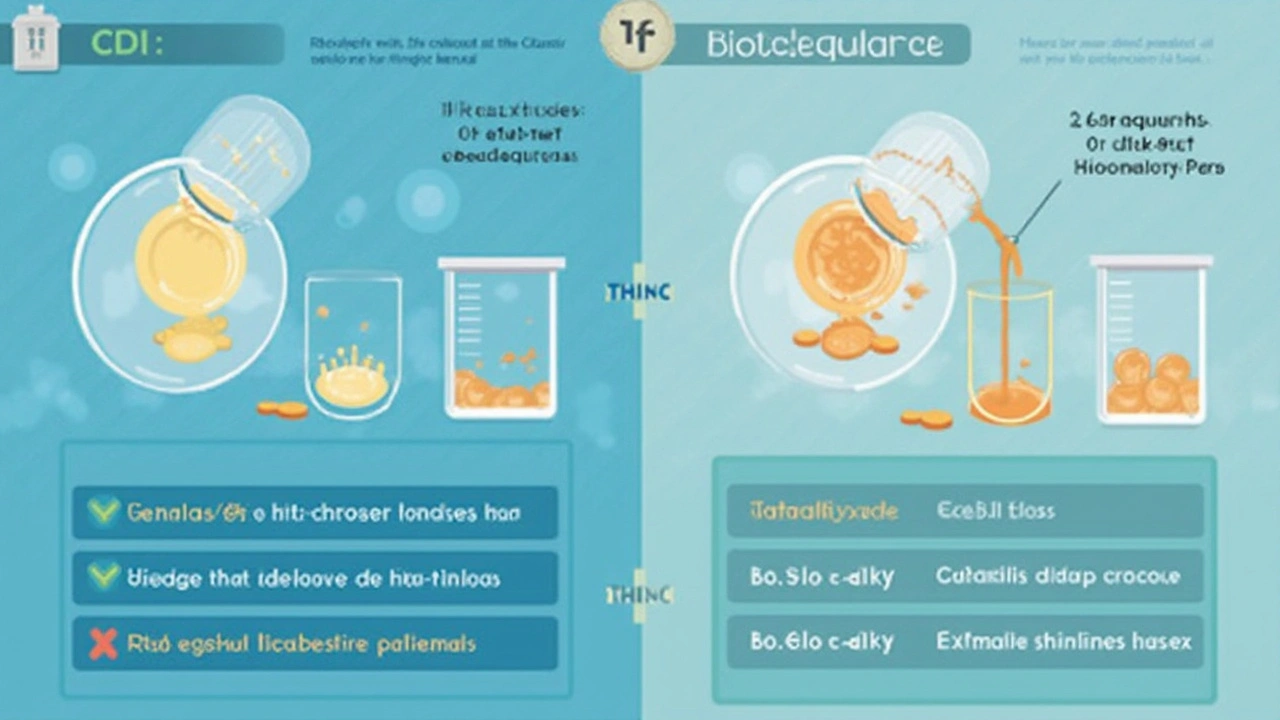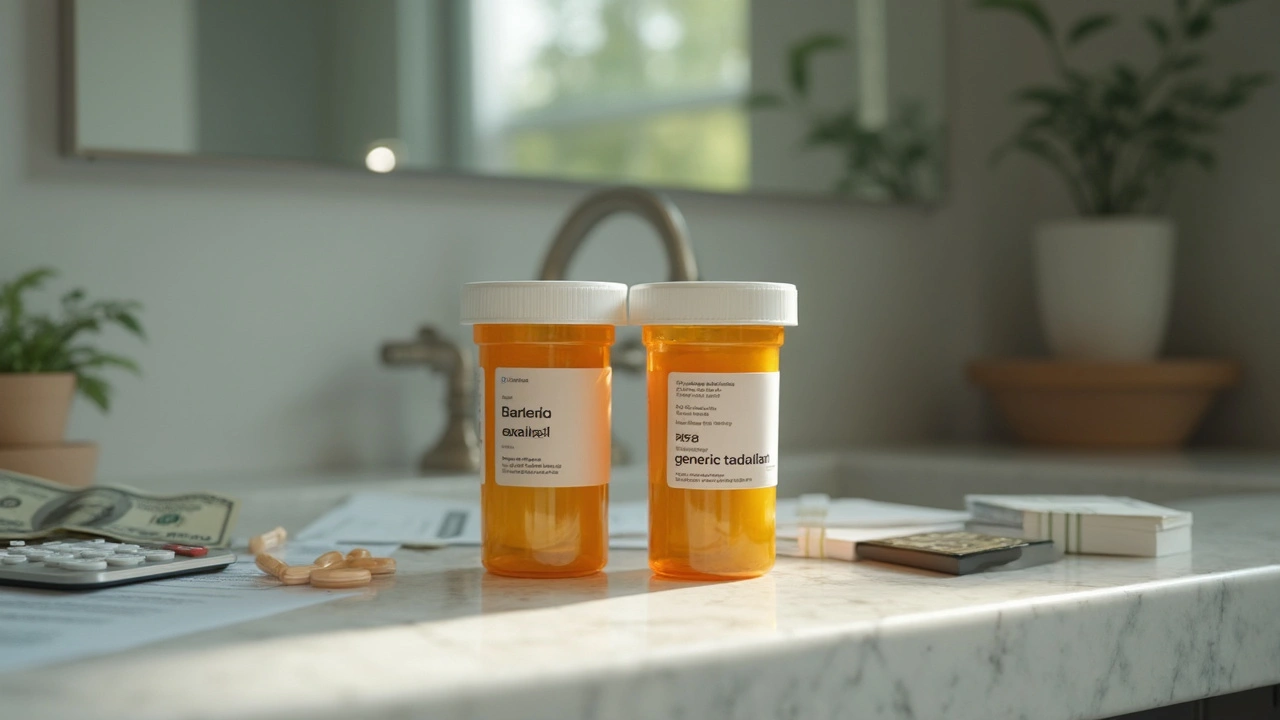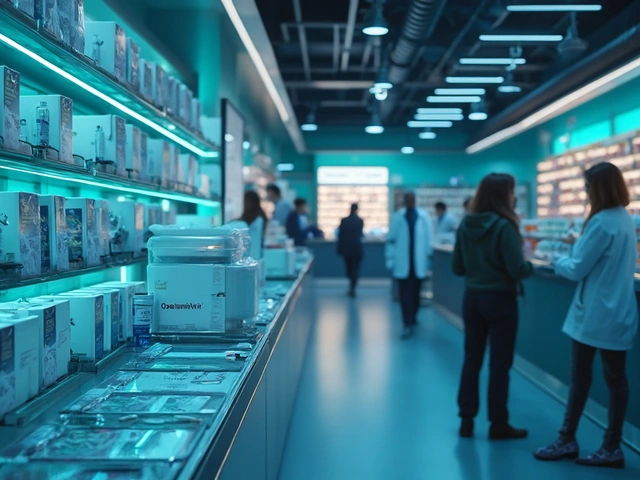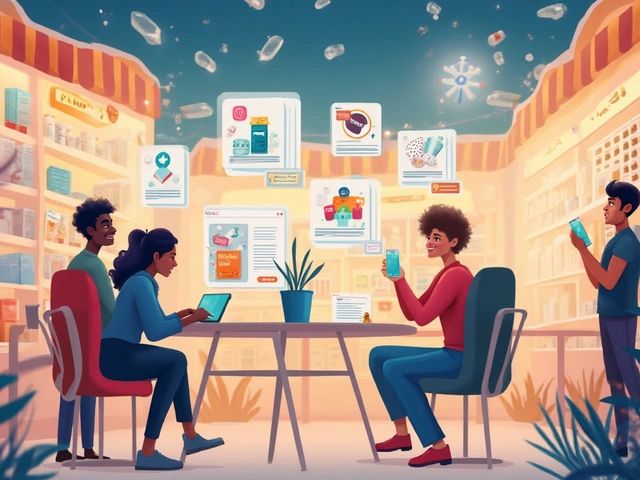Picture this: The doctor hands you a Cialis prescription, you head to the pharmacy, and suddenly your jaw drops at the price. Next thing you know, you’re googling cheaper options, but every site just throws buzzwords and confusing studies at you. So, what actually changes if you swap brand-name Cialis for a generic tadalafil? Is it really the same pill just with a less flashier label?
Breaking Down Tadalafil: What's Really Inside?
It’s easy to think the name on the box makes all the difference. But pull back the curtain, and both brand and generic tadalafil have the same active ingredient that makes things work in the bedroom. Tadalafil works as a PDE5 inhibitor, boosting blood flow where you want it. When it comes to regulatory standards, the FDA and other agencies around the globe hold generics to the same safety and bioequivalence rules as branded drugs. That means a generic pill has to match the absorption, breakdown, and performance of the brand pill in your body.
Here are some interesting numbers to chew on: For a generic to get approval, its area under the plasma concentration curve (AUC) and its maximum concentration (Cmax) must fall within 80% to 125% of the original product, statistically speaking. In plain English, that means these pills have to act the same in your bloodstream, not just look similar. Side effects? Same rules apply, because the inactive ingredients might shift but the way tadalafil acts doesn’t.
If you’re picturing chalky white pills, don’t worry. Generics can come in different shapes and colors, but what matters is performance. The 2018 study published in the journal "Current Medical Research and Opinion" showed that men couldn’t tell the difference in effectiveness or side effects between brand Cialis and generic tadalafil. That’s not marketing fluff—just a clinical reality.
The Real Cost Divide: How Much Are You Actually Saving?
This is where things get interesting, and maybe a little irritating if you’ve been paying for brand-name pills all this time. The price tag on brand Cialis in 2025 can hit $70-80 per 20mg dose in the U.S. Compare that to generics, which often sell for $1-5 per pill depending on your pharmacy or online source. That difference adds up fast, especially if your insurance company isn’t as generous as it used to be.
Check out this price breakdown for a one-month supply (30 pills):
| Type | Average Price (1-month supply, 20mg) |
|---|---|
| Brand Cialis | $2100 - $2400 |
| Generic tadalafil (U.S. pharmacy) | $40 - $150 |
| Generic tadalafil (international pharmacy) | $25 - $80 |
Why such a massive gap? Brand manufacturers price for research, name recognition, and patent monopolies. When those patents expire, competing companies enter with generics, creating a race to the lowest price. In 2024, Eli Lilly’s exclusivity on tadalafil ended, opening the door for dozens of FDA-approved generics to flood the market.
If you’re hunting for the best deals, international and online pharmacies often beat local chains like CVS or Walgreens. But double-check for legit sources—counterfeits are a real risk, and you don’t want surprises in the bedroom or elsewhere. Some trustworthy providers list licensed generic tadalafil competitors with customer reviews, efficiency stats, and payment protections, making it simple to compare cost and safety side by side.

Bioequivalence: The Science Behind 'Same as Brand'
The FDA and EMA don’t just take a manufacturer’s word that their generic works the same. They demand rigorous bioequivalence studies. These are no joke: you’ll see around 24-36 healthy volunteers take both the brand and the generic, then labs track blood levels hour by hour.
The analysis hammers down two numbers: Cmax (how high the drug level gets) and AUC (how long the body is exposed to the drug). If the mean ratio falls between 0.8 and 1.25 (as a confidence interval), bingo—this generic passes with flying colors. In other words, your body doesn’t know if you’re swallowing a brand name or a budget pill.
You might ask: but what about the chalky fillers or those weird colors? For most people, those extras don’t make a bit of difference. The only exceptions are rare allergies or sensitivities. Still, the thing to watch for is consistency—some low-tier generic factories skip on quality control. But the major generics making the market in 2025 (think Teva, Mylan, Cipla, Aurobindo) hold the same pharmaceutical elite status as their brand rivals. And they have to keep up; the FDA inspects these facilities often.
A 2021 study out of the University of Florida found virtually identical efficacy rates—a little over 75%—between men taking brand versus FDA-approved generics, with side effect profiles overlapping nearly entirely. Even doctors found it hard to distinguish who was on what in blinded trials.
Real-Life Impact: What Do Patients Actually Notice?
Here’s where the numbers get personal. Guys worry that trading down to generics means a weaker effect or unpredictable results. In real life, switching from brand Cialis to generic tadalafil usually means the same performance, same reliability, and a much happier wallet. There might be small differences in release speed if the non-active fillers are tweaked, but those margins are tiny, often not even noticeable.
Pharmacists give a helpful tip: If you notice a difference, try the generic for two to three doses to adjust, since your body can take a few days to get used to tiny changes. Only a small minority experience side effects with one generic but not another, usually due to those fillers—so if you react poorly, switch brands until you find your fit.
From survey data in 2023: About 87% of men reported equal satisfaction after the swap, and most couldn’t remember which they were taking two months later. The biggest reported difference? People felt less stressed about taking their pills because they weren't stressing about the price tag.
Insider tip: Always compare generic tadalafil doses, since some brands sell oddball strengths (like 5mg or 10mg) to catch bargain hunters. Check that your pharmacy or online supplier is transparent with potency reports—look for batch numbers and regulatory approval marks. And check expiry dates, especially with imported or discounted meds.

Smart Ways to Save: Tips for Getting the Most from Generics
Feeling lost in a sea of choices? There are a few ways to hack the system and still get what you pay for. Buy in bulk—most online or international pharmacies drop the per-pill price with bigger orders. Consider splitting higher-strength tablets, if you're comfortable with a pill cutter and your doctor gives the green light, since larger doses often cost less per milligram.
If you’re on insurance, ask your provider which generics are on their “preferred list” to supercharge your copay savings. But don’t be afraid to skip insurance altogether if cash prices beat your copay—that’s shockingly common with generics lately. Pharmacy discount cards and online coupon codes can also undercut list prices. Just make sure you stay within legal channels—fakes are rampant on random social media ads or rogue websites.
One more heads-up: Check out review communities and forums dedicated to ED meds. Real user stories give a good vibe check on which generic tadalafil brands have loyal followings. People are fast to point out any duds, especially when it comes to delivery speed, tablet taste, or even packaging annoyances.
And a bonus life hack: If you take other meds, make sure your pharmacist double-checks for interactions. Tadalafil plays nice with most scripts but can run into trouble with heart meds or nitrates, so don’t skip the safety check.
The gap between brand and generic tadalafil is shrinking by the day. Unless you’re deeply loyal to a particular shape or shade of pill, the science says you’ll get the same performance—and statistics—and with those savings, you can focus more on living than budgeting.






David McClone
July 18, 2025 AT 16:38Ah, the eternal dance between generic and brand-name meds — always ripe for debate and skepticism, right? I mean, sure, the post presents bioequivalence and price savings, but how much can we really trust the generic manufacturers? The FDA's standards might be strict, but the variability in inactive ingredients, manufacturing processes, and batch-to-batch consistency can't be ignored if we're aiming for true parity.
Also worth pondering: are the clinical trials for bioequivalence enough to guarantee the exact same therapeutic effects in every user? Or just a regulatory minimum? I can't help but suspect there's always some subtle difference that gets brushed under the rug.
Isn't it curious how the big pharma brands spend billions on marketing exactly because the perception of quality exceeds generic alternatives? It's not just the chemical compound, but the entire experience — from pill color to packaging — that seems to influence patient confidence and outcomes.
So, while the argument for generics is compelling from an economic standpoint, I remain cautiously skeptical about equating them unequivocally. Anyone else feeling the same distrust, or am I just a paranoid conspiracy theorist?
Taryn Thompson
July 23, 2025 AT 13:18I appreciate that this guide breaks down the science behind generics versus brand name Tadalafil, especially emphasizing bioequivalence. This isn’t just a marketing gimmick — generics must demonstrate that their active ingredient is absorbed at a similar rate and extent as the original drug, which is a rigorous standard.
Of course, excipients might differ, potentially causing minor variance in individual tolerability, but for the vast majority, the therapeutic outcomes are indistinguishable. It's what the clinical pharmacology supports, and it’s why healthcare providers often confidently prescribe generics.
Moreover, the significant cost difference should never be overlooked. Many patients cannot afford branded medications, and lower-cost generics improve adherence and overall health outcomes.
When in doubt, consult a pharmacist or healthcare provider about specific brands and formulations. Ultimately, this article provides much-needed clarity and should encourage more informed decisions rather than fears.
Anoop Choradia
July 26, 2025 AT 21:51Esteemed colleagues, permit me to interject with a critical perspective on this matter which often falls prey to rampant misinformation. The discourse surrounding generic versus branded tadalafil must adhere to stringent pharmacological protocols, lest we indulge in amateurish conjectures.
Bioequivalence is indeed a well-established parameter, mandated by regulatory authorities with exacting criteria. However, one ought to remain vigilant against counterfeit or subpar generics flooding less regulated markets, thereby compromising therapeutic integrity and patient safety.
Therefore, the unequivocal endorsement of generics without caveats may be misleading. A discerning consumer must evaluate the provenance of the medication, scrutinize manufacturing certifications, and demand empirical evidence beyond superficial price differentials.
In summary, while generics confer economic advantages, only those produced under rigorously monitored conditions can approximate the efficacy and safety profile of their branded counterparts.
Stephanie Colony
August 1, 2025 AT 02:51Oh, here we go again with the typical blind worship of generics because they’re cheaper. Honestly, what is that supposed to prove? Lower price doesn’t automatically equate to equal quality—far from it.
The so-called bioequivalence studies are a rudimentary baseline, nothing definitive. Why are we so quick to ignore the subtleties that differentiate brand formulations? These differences can make or break patient outcomes, period.
And let me just say, if you think switching to cheap generics is patriotic or somehow more virtuous, you're deluding yourselves. Supporting well-established, innovative pharma brands not only guarantees quality but also fuels future medical breakthroughs.
Wake up, people. There’s a reason these companies invest heavily in R&D and quality control. Generics might be convenient, but they are no replacement for the gold standard.
Brenda Taylor
August 5, 2025 AT 04:05Wow, lots of passionate opinions here! Personally, I just want what’s gonna work for me without wasting a ton of cash lol. Honestly, I haven’t noticed any difference between the generic and brand versions, and the price difference is huge.
That said, I am a bit wary of buying generics all over the place. I try to make sure I get them from reputable pharmacies because I don’t wanna end up with fake meds, you know?
Also, the article was super helpful in explaining the science behind it all—like how they have to prove bioequivalence and stuff. Makes me feel a bit more confident taking generics.
Has anyone else felt like their meds were different when switching from brand to generic?
Mangal DUTT Sharma
August 8, 2025 AT 09:51Namaste from India! I really appreciate the thorough breakdown here because so many people in my community speak about generics but also share stories of side effects and different responses.
In my experience, some generics work perfectly fine and save so much money, especially when brand medication costs too much for many people.
However, I’ve also observed that certain batches or brands cause mild discomfort or slower onset, which makes me think it’s not just the active ingredient but the formulation nuances.
Therefore, it is critical for us to remain vigilant, buy from trusted sources, and consult specialists if any adverse effects occur.
Thanks for highlighting both the science and practical tips—it’s much needed info for us.
bhavani pitta
August 10, 2025 AT 17:25Honestly, I find a lot of the hype around both sides exhausting. Brand loyalists acting like generics are poison, and generics defenders who treat brands like some holy grail.
From what I’ve gathered, the reality is more nuanced. Some generics are very well made and can absolutely replace brands, but others might fall short. It matters where you buy, which manufacturer, and even individual metabolism.
Also, let’s not forget the placebo effect and perceptions that play into how effective someone thinks a drug is.
This post does a good job of presenting facts, but people tend to be emotional and personal when it comes to meds, especially sensitive ones like tadalafil.
Just hoping for more open conversations without dramatic exaggeration on either side.
Jessica Romero
August 12, 2025 AT 05:31Adding to the conversation, from a pharmacological perspective, demands a detailed consideration of bioavailability data, pharmacokinetics, and patient-specific factors. While generics meet FDA standards, the variability in excipients can affect absorption rates subtly, thus impacting efficacy and side-effect profiles for certain individuals.
The key lies in personalized medicine: no single answer fits all. Clinicians should monitor responses when switching formulations carefully and adjust therapy accordingly.
Furthermore, economic benefits cannot be overlooked for population health outcomes, yet pharmacovigilance remains essential to identify any discrepancies in generics rapidly.
Therefore, informed choice supported by healthcare advice remains paramount rather than wholesale acceptance or rejection.
Abigail Lynch
August 15, 2025 AT 02:58Hmm, I can't help but feel something fishy about the whole 'bioequivalence' story. Who’s to say the regulators aren't just brushing over the details to give the generic manufacturers a free pass? Big pharma might be greedy, but generics could be cutting corners in ways we don’t hear about.
Plus, every medicine affects people differently. Just because a test says the active ingredient is present in the same amount doesn’t mean you’ll get the same experience or outcomes.
My advice? If you try generics, be cautious, watch for side effects, and don’t assume they’re magically the same. There's more beneath the surface here, and we should all be aware of that.
Paul Hill II
August 17, 2025 AT 16:38This post is a solid primer on what differentiates generic tadalafil from branded, particularly in terms of price and bioequivalence. It concisely covers the essentials without unnecessary fluff.
I think discussions like these are crucial because misconceptions abound — either people fear generics unnecessarily or blindly trust them without understanding the nuances.
My takeaway is that generics are a highly valuable option when sourced correctly and monitored by healthcare professionals. They greatly expand access without sacrificing meaningful clinical effect.
Smart consumers should always stay informed and consult professionals, but let’s appreciate the role generics play in modern medicine.